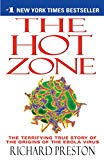
The book is in four sections:
The book starts with "Charles Monet" visiting Kitum Cave during a camping trip to Mount Elgon in Central Africa. Not long after, he begins to suffer from a number of symptoms, including vomiting, diarrhea and red eye. He is soon taken to Nairobi Hospital for treatment, but his condition deteriorates further and he goes into a coma while in the waiting room. This particular filovirus is called Marburg virus.
Dr. Nancy Jaax had been promoted to work in the Level 4 Biosafety containment area at USAMRIID, and is assigned to research Ebola virus. While preparing food for her family at home, she cuts her right hand. Later, while working on a dead, EBOV-infected monkey, one of the gloves on the hand with the open wound tears, and she is almost exposed to contaminated blood, but does not get infected. Nurse Mayinga is also infected by a nun and elects to visit Nairobi Hospital for treatment, where she succumbs to the disease.
In Reston, Virginia, less than fifteen miles (24 km) away from Washington, DC, a company called Hazelton Research once operated a quarantine center for monkeys that were destined for laboratories. In October 1989, when an unusually high number of their monkeys began to die, their veterinarian decided to send some samples to Fort Detrick (USAMRIID) for study. Early during the testing process in biosafety level 3, when one of the flasks appeared to be contaminated with harmless pseudomonas bacterium, two USAMRIID scientists exposed themselves to the virus by wafting the flask. They later determine that, while the virus is terrifyingly lethal to monkeys, humans can be infected with it without any health effects at all. This virus is now known as Reston virus (RESTV).
Finally, the author himself goes into Africa to explore Kitum Cave. On the way, he discusses the role of AIDS in the present, as the highway they were on, sometimes called the "AIDS Highway," or the "Kinshasa Highway" was where it first appeared. Equipped with a Hazmat suit, he enters the cave and finds a large number of animals, one of which might be the virus carrier. At the conclusion of the book, he travels to the quarantine facility in Reston. He finds the building abandoned and deteriorating. He concludes the book by claiming that Ebola will be back.
Already have an account? Log In Now